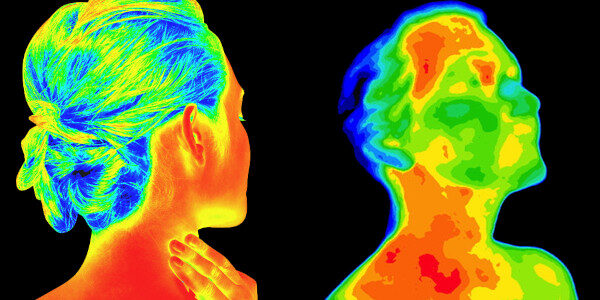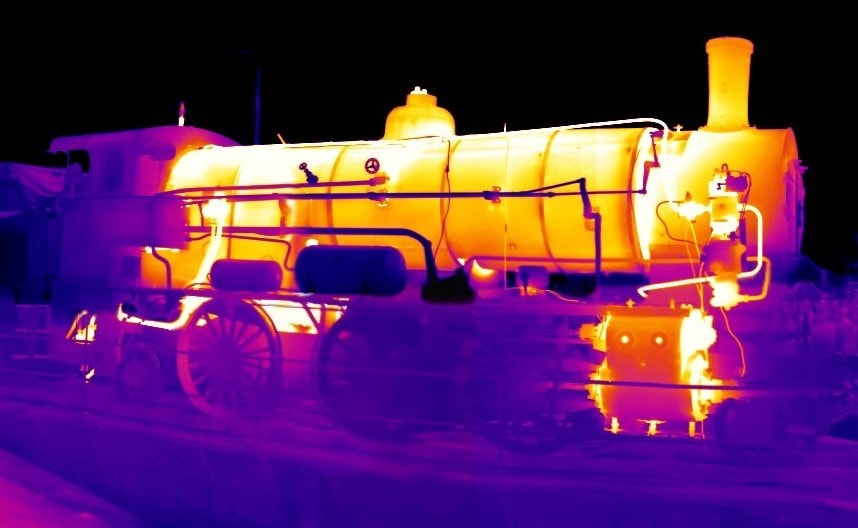
Body temperature is a fundamental variable in many fields. Due to the range of temperatures at which the human body can function, measuring its internal or surface temperatures or its temperature relative to the environment is essential for medicine, the world of work, and leisure.
What is body temperature?
Even though the question might seem simple, there is no one body temperature: there are several. For example, in medicine, the tympanic temperature (measured in the ear) usually ranges from 35.7°C to 37.8°C, while oral temperature (in the mouth) hovers between 33.2°C and 38.1°C. Measurement in women. In men, it is slightly higher.
Measured on the skin, body temperature varies significantly depending on where exactly it’s taken. What’s more, body temperature varies throughout the day, depending on the ambient temperature, and it changes with different activities being done. For example, it increases during intense work.

Thermal (infrared) cameras help see changes in surface temperature, as well as detecting the temperature of the surfaces and possible heat losses or gains.
Body temperature and its relationship to work
As part of Occupational Risk Prevention (ORP), there are a set of rules on the temperature at which it is possible to work, depending on the job being performed. The purpose of these standards is to ensure that workers are taken care of and are comfortable.
In Spain, for instance, the temperature of premises with sedentary jobs should be between 17°C and 27°C. If light work is being done, that range goes down to 14°C to 25°C. Though these are not requirements, the INSHT recommends:
- Summer: between 23°C and 26°C.
- Winter: between 20°C and 24°C.
Different countries have different regulations, although almost all have the same limits, which are the limits of the human body. Humans have evolved within a certain temperature range, so we are very sensitive to certain extremes.
Apparent temperature is often more important than the actual temperature
While temperature is an objective measure of the amount of thermal energy in the air, apparent temperature is the temperature that humans perceive. As it is subjective, it varies similarly for everyone:
- More wind, more cool. As airspeed increases, it feels cooler or colder. This is because the rate at which the human body dissipates energy increases when multiplying by the heat transfer coefficient. That’s also why we blow on soup to cool it.
- Less shade, more heat. In general, shade cools (though not all types of shade are the same: shade from trees is particularly cool because vegetation releases water), so it is common to feel much hotter when you are in the sun, even though the air temperature does not vary.
- More movement, more heat. The human body generates heat when working, and more intense work creates more heat.
Monitoring workers’ body temperature
In keeping with Spain, the [Occupational Risk Prevention Law] (Ley de Prevención de Riesgos Laborales) (LPRL) tells companies what temperatures they must consider when assessing the risks of heat and cold, as well as ensuring the safety of their employees. Depending on how extreme the temperatures are, they may:
What to do for the cold in terms of work
Indoors, using air conditioners or keeping stable temperatures through bioclimatic mechanisms (or a mix of the two) with the aim of staying within legal and comfortable limits. The goal is to prevent body temperature from dropping.
Outdoors, dealing with the cold is more complicated, but there are some solutions like setting up windbreaks that can prevent some of the apparent temperature behind the cold. In some particularly cold regions with jobs that are very specific to those locations, it is even possible to deploy some kind of tent-type cover; it’s even an option to build temporary structures to enclose the space.
Though this requires a lot of energy, there is also the alternative of using heating lamps, whether they are gas stoves or electric radiators. This is usually essential if it is very cold or for carrying out tasks that require a lot of skill, as is the case in field hospitals.
What to do about the heat at work

Point3D Commercial Imaging Ltd.,
Here are some procedures to prevent body temperatures from exceeding dangerous upper thresholds. Some are time-worn solutions, such as hydrating regularly: sweat increases the rate at which we dissipate thermal energy and cools the body. Fans make bodies cool down faster, and they use very little energy.
While we can’t forego PPE when necessary, we can wear breathable clothing when possible; it should also cover the skin to help keep the sun’s rays from hitting us. Caps, hats, or sunshades are very helpful in this regard. The shade of a tree, if available, is even more so.
It’s also advisable not to work in the heat for long periods of time; pause to rest and cool down. You should also stop even stop if the weather conditions are dangerous (such as 50°C weather or even less extremes).
Main image: thermogears,





There are no comments yet